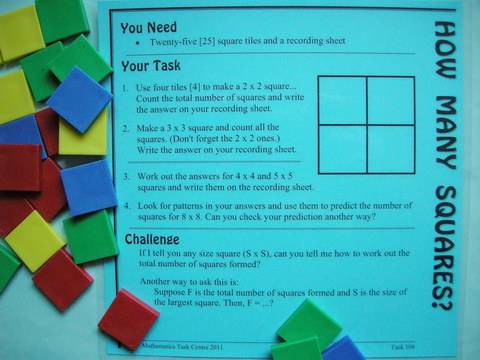
How Many Squares?Task 108 ... Years 4 - 10SummaryBuild a new square from the Size 1 squares supplied. Many patterns and generalisations then develop depending on what you count. The simplest is to just consider the relationship between the size of the new triangle and the number of Size 1 pieces which make it up. The problem becomes more complex if you look into the new size you create to look for squares of any size within it. For example, a Size 3 has Size 2s within it as well as Size 1s.This task is similar to Task 48, How Many Triangles?, which is a little more complex. How Many Squares also appears on the Picture Puzzles Pattern & Algebra A menu where the problem is presented using one screen, two learners, concrete materials and a challenge. |
Materials
Content
|

IcebergA task is the tip of a learning iceberg. There is always more to a task than is recorded on the card. |
The overall objective of the problem is to be able to predict the number of squares of any size inside a bigger square made of Size 1 squares, ie: the unit squares provided. The card guides students towards this by breaking the problem into smaller parts for them. In discussion with them it is important to highlight that this is the strategy implied by the task card. Question 1 allows students room to discover that there are actually 5 squares involved. The four obvious Size 1s and the newly created Size 2. Aha! So now for the 3 x 3 square we must look for Size 1, Size 2 and Size 3 squares. Size 1 = 9 and Size 3 = 1 are fairly obvious, but what about Size 2? For some students it helps to imagine that the Size 2 in the top left is translated to the right (it can only move one unit) then down (again only one unit) then left. So Size 2 = 4. Try that reasoning again with 4 x 4 and Size 1 = 16, Size 4 = 1. This time it is Size 3 that can translate right, down and left only one unit at a time. So what happens with Size 2? It can now translate to the right twice, giving three Size 2s on the top line. Then it can translate down one unit and move left twice, then down one more unit and move right twice. So, Size 2 = 9 and it is about time to introduce the strategy of Make a Table.
Were we to be presented with this table instead:
which is the sort of table often offered in textbooks to encourage students to predict what comes next, then there would be more difficulty in discerning a generalisation. The full table, arrived at by breaking the problem into parts, suggests at least two ways of generalising:
Another way to explore this number pattern is to graph the ordered pairs represented by the second table. Is there a visual pattern?
And if you wish to explore the sum of the squares further, investigate Task 101, Pyramid Puzzle where you will find that the F results are governed by a cubic function. Mmm, power of three and three lines in the difference table before a line of constants. I wonder... |
Whole Class InvestigationTasks are an invitation for two students to work like a mathematician. Tasks can also be modified to become whole class investigations which model how a mathematician works. |
Schools usually have sufficient square tiles or cubes to be able to explore this problem. However, if you have some large cardboard squares (about 20cm2) you can begin the lesson by exploring the growing squares on the floor or a central table. From here the problem can be led by an Investigation Guide. An example is provided in the Year 9 & 10 Maths With Attitude kit listed below. At this stage, How Many Squares? does not have a matching lesson on Maths300.
|
Is it in Maths With Attitude?Maths With Attitude is a set of hands-on learning kits available from Years 3-10 which structure the use of tasks and whole class investigations into a week by week planner. |
The How Many Squares? task is an integral part of:
|